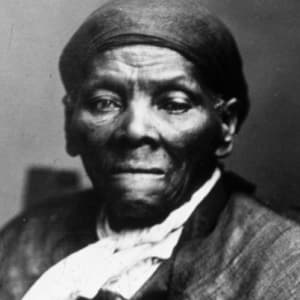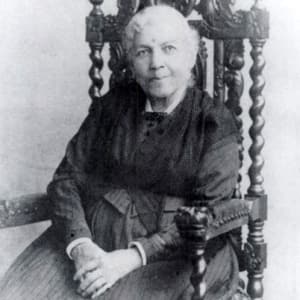
Harriet Tubman
Harriet Tubman escaped slavery to become a leading abolitionist. She led hundreds of enslaved people to freedom along the route of the Underground Railroad.
Who Was Harriet Tubman?
Born into slavery in Maryland, Harriet Tubman (c. 1820 to March 10, 1913) escaped to freedom in the North in 1849 to become the most famous "conductor" on the Underground Railroad. Tubman risked her life to lead hundreds of family members and other slaves from the plantation system to freedom on this elaborate secret network of safe houses. A leading abolitionist before the American Civil War, Tubman also helped the Union Army during the war, working as a spy among other roles.
After the Civil War ended, Tubman dedicated her life to helping impoverished former slaves and the elderly. In honor of her life and by popular demand, in 2016, the U.S. Treasury Department announced that Harriet Tubman will replace Andrew Jackson on the center of a new $20 bill.
Harriet Tubman and the New $20 Bill
In April 2016, the U.S. Treasury Department announced that Harriet Tubman would replace Andrew Jackson on the center of a new $20 bill. The announcement came after the Treasury Department received a groundswell of public comments, following Women on 20s’ campaign calling for a notable American woman to appear on U.S. currency. “Secretary Lew’s choice of the freed slave and freedom fighter Harriet Tubman to one day feature on the $20 note is an exciting one, especially given that she emerged as the choice of more than half a million voters in our online poll last Spring,” Women on 20s stated on its website. “Not only did she devote her life to racial equality, she fought for women’s rights alongside the nation’s leading suffragists.”
In June 2015, Treasury Secretary Jacob J. Lew was criticized for saying that it was likely a woman would appear on the $10 bill, which features a portrait of Alexander Hamilton, the influential founding father who found renewed popularity because of the hit Broadway musical Hamilton. The ultimate decision to have Tubman replace Jackson, a slaveholder who played a role in the removal of Native Americans from their land, was widely praised.
Harriet Tubman and the Underground Railroad
In 1849, following a bout of illness and the death of her owner, Harriet Tubman decided to escape slavery in Maryland for Philadelphia. She feared that her family would be further severed and was concerned for her own fate as a sickly slave of low economic value. Two of her brothers, Ben and Harry, accompanied her on September 17, 1849. However after a notice was published in the Cambridge Democrat offering a $300 reward for the return of Araminta, Harry and Ben, Tubman’s brothers had second thoughts and returned to the plantation. Harriet had no plans to remain in bondage. Seeing her brothers safely home, she soon set off alone for Pennsylvania.
Making use of the network known as the Underground Railroad, Tubman traveled nearly 90 miles to Philadelphia. She crossed into the free state of Pennsylvania with a feeling of relief and awe, and recalled later: “When I found I had crossed that line, I looked at my hands to see if I was the same person. There was such a glory over everything; the sun came like gold through the trees, and over the fields, and I felt like I was in Heaven.”
Rather than remaining in the safety of the North, Tubman made it her mission to rescue her family and others living in slavery via the Underground Railroad. In December 1850, Tubman received a warning that her niece Kessiah was going to be sold, along with her two young children. Kessiah’s husband, a free black man named John Bowley, made the winning bid for his wife at an auction in Baltimore. Harriet then helped the entire family make the journey to Philadelphia. This was the first of many trips by Tubman, who earned the nickname “Moses” for her leadership. Over time, she was able to guide her parents, several siblings and about 60 others to freedom.
The dynamics of escaping slavery changed in 1850, with the passage of the Fugitive Slave Law. This law stated that escaped slaves could be captured in the North and returned to slavery, leading to the abduction of former slaves and free blacks living in Free States. Law enforcement officials in the North were compelled to aid in the capture of slaves, regardless of their personal principles. In response to the law, Tubman re-routed the Underground Railroad to Canada, which prohibited slavery categorically.
In December 1851, Tubman guided a group of 11 fugitives northward. There is evidence to suggest that the party stopped at the home of abolitionist and former slave Frederick Douglass.
In April 1858, Tubman was introduced to the abolitionist John Brown, who advocated the use of violence to disrupt and destroy the institution of slavery. Tubman shared Brown’s goals and at least tolerated his methods. Tubman claimed to have had a prophetic vision of Brown before they met. When Brown began recruiting supporters for an attack on slaveholders at Harper’s Ferry, he turned to “General Tubman” for help. After Brown’s subsequent execution, Tubman praised him as a martyr.
Harriet Tubman remained active during the Civil War. Working for the Union Army as a cook and nurse, Tubman quickly became an armed scout and spy. The first woman to lead an armed expedition in the war, she guided the Combahee River Raid, which liberated more than 700 slaves in South Carolina.
When and Where Was Harriet Tubman Born?
Harriet Tubman was one of nine children born between 1808 and 1832 to enslaved parents in Dorchester County, Maryland. The year of Harriet Tubman’s birth is unknown, although it probably occurred between 1820 and 1825. Originally named Araminta Harriet Ross, Harriet was nicknamed “Minty” by her parents, Harriet “Rit” Green, who was owned by Mary Pattison Brodess, and Ben Ross, who was owned by Anthony Thompson (Thompson and Brodess eventually married). Araminta changed her name to Harriet around the time of her marriage, possibly to honor her mother.
Early Life
Harriet Tubman’s early life was full of hardship. Mary Brodess’ son Edward sold three of her sisters to distant plantations, severing the family. When a trader from Georgia approached Brodess about buying Rit’s youngest son, Moses, Rit successfully resisted the further fracturing of her family, setting a powerful example for her young daughter.
Physical violence was a part of daily life for Tubman and her family. The violence she suffered early in life caused permanent physical injuries. Harriet later recounted a particular day when she was lashed five times before breakfast. She carried the scars for the rest of her life. The most severe injury occurred when Tubman was an adolescent. Sent to a dry-goods store for supplies, she encountered a slave who had left the fields without permission. The man’s overseer demanded that Tubman help restrain the runaway. When Harriet refused, the overseer threw a two-pound weight that struck her in the head. Tubman endured seizures, severe headaches and narcoleptic episodes for the rest of her life. She also experienced intense dream states, which she classified as religious experiences.
The line between freedom and slavery was hazy for Tubman and her family. Harriet Tubman’s father, Ben, was freed from slavery at the age of 45, as stipulated in the will of a previous owner. Nonetheless, Ben had few options but to continue working as a timber estimator and foreman for his former owners. Although similar manumission stipulations applied to Rit and her children, the individuals who owned the family chose not to free them. Despite his free status, Ben had little power to challenge their decision.
READ ARTICLE: A Rare Photo & Royal Shawl in the Smithsonian NMAAHC Collection Honor Harriet Tubman's Strength & Bravery
Harriet Tubman’s Family
In 1844, Harriet married a free black man named John Tubman. At the time around half of the African-American people on the eastern shore of Maryland were free, and was not unusual for a family to include both free and enslaved people, as did Tubman’s. Little is known about John Tubman or his marriage to Harriet, including whether and how long they lived together. Any children they might have had would have been considered enslaved, since the mother’s status dictated that of any offspring. John declined to make the voyage on the Underground Railroad with Harriet, preferring to stay in Maryland with a new wife.
In 1869, Harriet married a Civil War veteran named Nelson Davis. In 1874, the couple adopted a baby girl named Gertie.
Later Life
In early 1859, abolitionist Senator William H. Seward sold Tubman a small piece of land on the outskirts of Auburn, New York. The land in Auburn became a haven for Tubman’s family and friends. Tubman spent the years following the war on this property, tending to her family and others who had taken up residence there.
Despite Harriet’s fame and reputation, she was never financially secure. Tubman’s friends and supporters were able to raise some funds to support her. One admirer, Sarah H. Bradford, wrote a biography entitled Scenes in the Life of Harriet Tubman, with the proceeds going to Tubman and her family. Harriet continued to give freely in spite of her economic woes. In 1903, she donated a parcel of her land to the African Methodist Episcopal Church in Auburn. The Harriet Tubman Home for the Aged opened on this site in 1908.
Harriet Tubman’s Death
As Tubman aged, the head injuries sustained early in her life became more painful and disruptive. She underwent brain surgery at Boston’s Massachusetts General Hospital to alleviate the pains and "buzzing" she experienced regularly. Tubman was eventually admitted into the rest home named in her honor. Surrounded by friends and family, Harriet Tubman died of pneumonia on March 10, 1913. She was buried with military honors at Fort Hill Cemetery in Auburn.
Legacy
Harriet Tubman, widely known and well-respected while she was alive, became an American icon in the years after she died. A survey at the end of the 20th century named her as one of the most famous civilians in American history before the Civil War, third only to Betsy Ross and Paul Revere. She continues to inspire generations of Americans struggling for civil rights with her bravery and bold action.
When she died, the city of Auburn commemorated her life with a plaque on the courthouse. Tubman was celebrated in many other ways throughout the nation in the 20th century. Dozens of schools were named in her honor, and both the Harriet Tubman Home in Auburn and the Harriet Tubman Museum in Cambridge serve as monuments to her life. A 1978 movie, A Woman Called Moses, commemorated her life and career.
Related Videos
Ida B. Wells – Women's Rights(TV-PG; 1:27)
Frederick Douglass – Path to Freedom(TV-14; 1:31)
Abraham Lincoln – African American Soldiers(TV-14; 1:30)
Ida B. Wells – Civil Rights Pioneer(TV-PG; 1:49)
Rosa Parks – Civil Rights Pioneer(TV-14; 1:56)
Sojourner Truth – Abolitionist and Feminist(TV-PG; 1:59)
Frederick Douglass – From Slave to Soldier(TV-14; 2:02)
Frederick Douglass – Impassioned Speaker(TV-14; 2:24)
Frederick Douglass – Meet John Brown(TV-14; 2:25)
Abraham Lincoln – The Emancipation Proclamation(TV-14; 2:27)
Sojourner Truth – Mini Biography
Frederick Douglass – A Child No More(TV-14; 2:45)
Rosa Parks – Legacy(TV-14; 3:04)
Frederick Douglass – Mini Biography(TV-14; 3:28)
Nat Turner – Slave Rebellion(TV-PG; 3:36)
Frederick Douglass – Full Episode(TV-14; 46:34)




